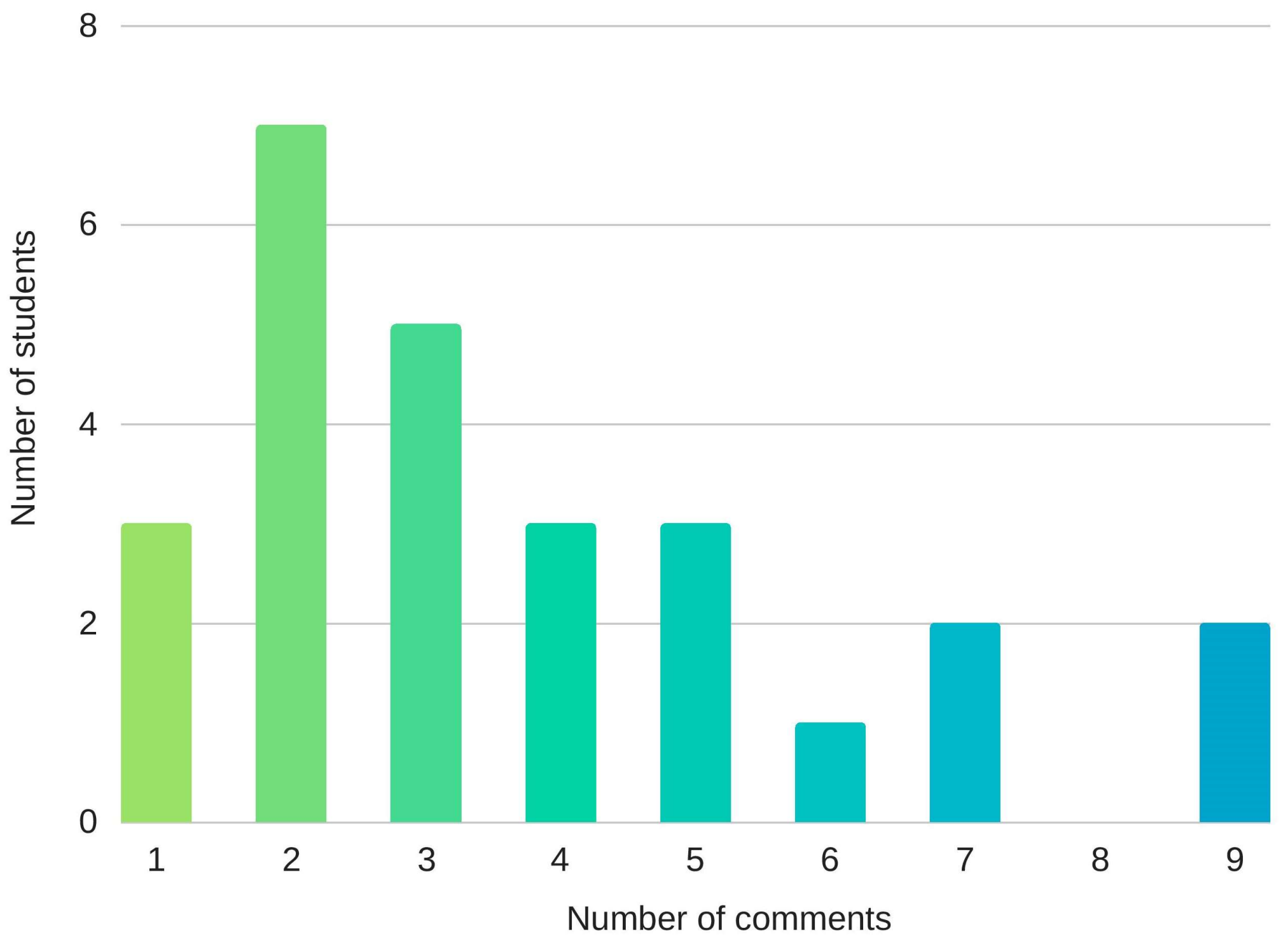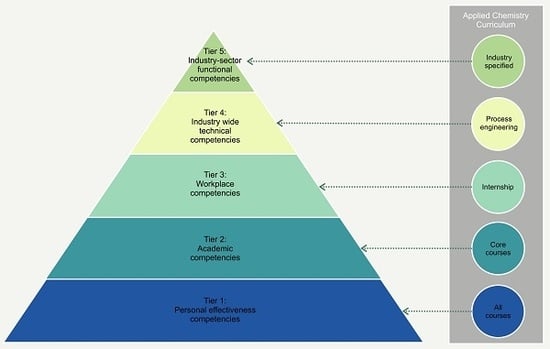Incorporating Sustainability into Engineering and Chemical Education Using E-Learning
Abstract
:1. Introduction
2. Theoretical Background
Research Question
- How does an online discussion on sustainable development in Zimbabwe foster student engagement?
- To what extent does online discussion and peer evaluation promote sustainability conscious critical discourse and reflection?
3. Methodology
3.1. Classroom Description
3.2. Instructional Strategy
3.3. Classroom Intervention
3.4. Data Collection
3.5. Data Analysis
3.5.1. Student Engagement
3.5.2. Quality of Response
4. Results
4.1. Student Engagement
4.2. Quality of Response
4.2.1. Online Discussion
4.2.2. Design Report
4.3. Collaborative Learning
5. Discussion and Conclusions
Author Contributions
Conflicts of Interest
References
- Sanganyado, E.; Lu, Z.; Fu, Q.; Schlenk, D.; Gan, J. Chiral pharmaceuticals: A review on their environmental occurrence and fate processes. Water Res. 2017, 124, 527–542. [Google Scholar] [CrossRef] [PubMed]
- Sanganyado, E.; Rajput, I.R.; Liu, W. Bioaccumulation of organic pollutants in Indo-Pacific humpback dolphin: A review on current knowledge and future prospects. Environ. Pollut. 2018, 237, 111–125. [Google Scholar] [CrossRef] [PubMed]
- Sanganyado, E.; Teta, C.; Masiri, B. Impact of African traditional worldviews on climate change adaptation. Integr. Environ. Assess. Manag. 2018, 14, 189–193. [Google Scholar] [CrossRef] [PubMed]
- Gwenzi, W.; Chaukura, N. Organic contaminants in African aquatic systems: Current knowledge, health risks and future research directions. Sci. Total Environ. 2018, 619–620, 1493–1514. [Google Scholar] [CrossRef]
- Bondarczuk, K.; Markowicz, A.; Piotrowska-Seget, Z. The urgent need for risk assessment on the antibiotic resistance spread via sewage sludge land application. Environ. Int. 2016, 87, 49–55. [Google Scholar] [CrossRef] [PubMed]
- Belu, R.; Chiou, R.; Tseng, T.-L. (Bill); Cioca, L. Advancing sustainable engineering practice through education and undergraduate research projects. In Education and Globalization; ASME: Montreal, QC, Canada, 2014; Volume 5, pp. 1–8. [Google Scholar]
- Teta, C.; Hikwa, T. Heavy Metal Contamination of Ground Water from an Unlined Landfill in Bulawayo, Zimbabwe. J. Heal. Pollut. 2017, 7, 18–27. [Google Scholar] [CrossRef]
- Allen, D.T.; Shonnard, D.R.; Huang, Y.; Schuster, D. Green Engineering Education in Chemical Engineering Curricula: A Quarter Century of Progress and Prospects for Future Transformations. ACS Sustain. Chem. Eng. 2016, 4, 5850–5854. [Google Scholar] [CrossRef]
- Sheehan, M.; Schneider, P.; Desha, C. Implementing a systematic process for rapidly embedding sustainability within chemical engineering education: a case study of James Cook University, Australia. Chem. Educ. Res. Pract. 2012, 13, 112–119. [Google Scholar] [CrossRef] [Green Version]
- Engineers Canada. National Guideline on Sustainable Development and Environmental Stewardship for Professional Engineers; Engineers Canada: Ottawa, ON, Canada, 2016. [Google Scholar]
- UNESCO. United Nations Decade of Education for Sustainable Development (2005–2014): International Implementation Scheme; UNESCO: Paris, France, 2005. [Google Scholar]
- Annan-Diab, F.; Molinari, C. Interdisciplinarity: Practical approach to advancing education for sustainability and for the Sustainable Development Goals. Int. J. Manag. Educ. 2017, 15, 73–83. [Google Scholar] [CrossRef]
- Wright, T.S.A. Definitions and frameworks for environmental sustainability in higher education. High. Educ. Policy 2002, 15, 105–120. [Google Scholar] [CrossRef]
- Hawkins, N.C.; Patterson, R.W.; Mogge, J.; Yosie, T.F. Building a sustainability road map for engineering education. ACS Sustain. Chem. Eng. 2014, 2, 340–343. [Google Scholar] [CrossRef]
- Louw, W. Green curriculum: Sustainable learning at a higher education institution. Int. Rev. Res. Open Distance Learn. 2013, 14. [Google Scholar] [CrossRef]
- Barnard, Z.; Van der Merwe, D. Innovative management for organizational sustainability in higher education. Int. J. Sustain. High. Educ. 2016, 17, 208–227. [Google Scholar] [CrossRef]
- Evans, N. (Snowy); Stevenson, R.B.; Lasen, M.; Ferreira, J.-A.; Davis, J. Approaches to embedding sustainability in teacher education: A synthesis of the literature. Teach. Teach. Educ. 2017, 63, 405–417. [Google Scholar] [CrossRef]
- Verbitskaya, L.A.; Nosova, N.B.; Rodina, L.L. Sustainable development in higher education in Russia: The case of St. Petersburg State University. High. Educ. Policy 2002, 15, 177–185. [Google Scholar] [CrossRef]
- Galgano, P.D.; Loffredo, C.; Sato, B.M.; Reichardt, C.; El Seoud, O.A. Introducing education for sustainable development in the undergraduate laboratory: Quantitative analysis of bioethanol fuel and its blends with gasoline by using solvatochromic dyes. Chem. Educ. Res. Pract. 2012, 13, 147–153. [Google Scholar] [CrossRef]
- Kradtap Hartwell, S. Exploring the potential for using inexpensive natural reagents extracted from plants to teach chemical analysis. Chem. Educ. Res. Pract. 2012, 13, 135–146. [Google Scholar] [CrossRef]
- Montañés, M.T.; Palomares, A.E.; Sánchez-Tovar, R. Integrating sustainable development in chemical engineering education: The application of an environmental management system. Chem. Educ. Res. Pract. 2012, 13, 128–134. [Google Scholar] [CrossRef]
- Pretorius, R.; Lombard, A.; Khotoo, A. Adding value to education for sustainability in Africa with inquiry-based approaches in open and distance learning. Int. J. Sustain. High. Educ. 2016, 17, 167–187. [Google Scholar] [CrossRef]
- Fenner, R.A.; Ainger, C.M.; Cruickshank, H.J.; Guthrie, P.M. Embedding sustainable development at Cambridge University Engineering Department. Int. J. Sustain. High. Educ. 2005, 6, 229–241. [Google Scholar] [CrossRef]
- Lourdel, N.; Gondran, N.; Laforest, V.; Brodhag, C. Introduction of sustainable development in engineers’ curricula. Int. J. Sustain. High. Educ. 2005, 6, 254–264. [Google Scholar] [CrossRef]
- Protsiv, M.; Rosales-Klintz, S.; Bwanga, F.; Zwarenstein, M.; Atkins, S. Blended learning across universities in a South-North-South collaboration: A case study. Heal. Res. Policy Syst. 2016, 14, 67. [Google Scholar] [CrossRef] [PubMed]
- Chen, B.; Chang, Y.-H.; Ouyang, F.; Zhou, W. Fostering student engagement in online discussion through social learning analytics. Internet High. Educ. 2018, 37, 21–30. [Google Scholar] [CrossRef]
- Mathews, A.L.; LaTronica-Herb, A. Using Blackboard to Increase Student Learning and Assessment Outcomes in a Congressional Simulation. J. Polit. Sci. Educ. 2013, 9, 168–183. [Google Scholar] [CrossRef]
- Kadnikova, E.N. “Molecules-in-Medicine”: Peer-evaluated presentations in a fast-paced organic chemistry course for medical students. J. Chem. Educ. 2013, 90, 883–888. [Google Scholar] [CrossRef]
- United States Department of Labor. Engineering Competency Model; United States Department of Labor: Washington, DC, USA, 2015.
- Richardson, J.C.; Ice, P. Investigating students’ level of critical thinking across instructional strategies in online discussions. Internet High. Educ. 2010, 13, 52–59. [Google Scholar] [CrossRef]
- Ouyang, F.; Scharber, C. The influences of an experienced instructor’s discussion design and facilitation on an online learning community development: A social network analysis study. Internet High. Educ. 2017, 35, 34–47. [Google Scholar] [CrossRef]
- Wise, A.; Zhao, Y.; Hausknecht, S. Learning Analytics for Online Discussions: Embedded and Extracted Approaches. J. Learn. Anal. 2014, 1, 48–71. [Google Scholar] [CrossRef]
- Dudukovic, M.P. Reaction engineering: Status and future challenges. Chem. Eng. Sci. 2010, 65, 3–11. [Google Scholar] [CrossRef]
- United Nations Economic and Social Council. Progress towards the Sustainable Development Goals: Report of the Secretary-General; United Nations Economic and Social Council: New York, NY, USA, 2016. [Google Scholar]
- Kahu, E.R. Framing student engagement in higher education. Stud. High. Educ. 2013, 38, 758–773. [Google Scholar] [CrossRef]
- Coates, H. The value of student engagement for higher education quality assurance. Qual. High. Educ. 2005, 11, 25–36. [Google Scholar] [CrossRef]
- Manwaring, K.C.; Larsen, R.; Graham, C.R.; Henrie, C.R.; Halverson, L.R. Investigating student engagement in blended learning settings using experience sampling and structural equation modeling. Internet High. Educ. 2017, 35, 21–33. [Google Scholar] [CrossRef]
- Czerkawski, B.C.; Lyman, E.W. An instructional design framework for fostering student engagement in online learning environments. TechTrends 2016, 60, 532–539. [Google Scholar] [CrossRef]
- Garrison, D.R.; Anderson, T.; Archer, W. Critical inquiry in a text-based environment: computer conferencing in higher education. Internet High. Educ. 1999, 2, 87–105. [Google Scholar] [CrossRef]
- Joksimović, S.; Dowell, N.; Poquet, O.; Kovanović, V.; Gašević, D.; Dawson, S.; Graesser, A.C. Exploring development of social capital in a CMOOC through language and discourse. Internet High. Educ. 2018, 36, 54–64. [Google Scholar] [CrossRef]


| Engineering Bodies | Competencies |
|---|---|
| Engineers Canada | C. Conduct engineering activities with an awareness of the associated risk and impact to protect the society, economy and the environment.
|
| UK Engineering Council | E3 Undertake engineering activities in a way that contributes to sustainable development.
|
| United States Department of Labor | Tier 4. Meet the needs of the present without compromising the ability of future generations to meet their own needs.
|
| Engineering Australia | PE2.2 Understand the social, cultural, global and environmental responsibilities of engineers and the need to employ principles of sustainable development
|
| Activities | Learning Outcomes | Source | |
|---|---|---|---|
| Type | Question | ||
| Online discussion | According to Milorad P. Dudukovic, “The key challenge for chemical reaction engineering is the development of new more efficient and profitable technologies. This is to be accomplished via an improved science-based scale-up methodology for transfer of molecular discoveries to sustainable nonpolluting processes that can meet the future energy, environmental, food and materials needs of the world.” Discuss how chemical reaction engineering can be used to meet the Millennium Development Goals in Zimbabwe, particularly goal 7 on environmental sustainability. |
| Research article [33] |
| Design report | Your local hospital received a report from the Environmental Monitoring Agency that stated that the effluent from the hospital is contaminating a local river. As a design engineer, you are tasked with proposing and designing a wastewater treatment plant for the local hospital. Write a design report for a cost-effective and innovative wastewater treatment plant for the hospital. Discuss how your design is sustainable and helps the nation to meet the MDG 7. |
| Report [34] |
| Dimensions | Key Aspects | Rank | |||
|---|---|---|---|---|---|
| 0 | 1 | 2 | 3 | ||
| Content | Argumentation | None | Unsupported | Simple | Complex |
| Discursiveness | Responsiveness | None | Acknowledge | Respond to single idea | Respond to multiple ideas |
| Elicitation | None | Unclear question | Question one person | Question whole group | |
| Reflectivity | Reflection in the question or submission | None | Shallow: reflection on own posts with no explanation | Deep: learning process shape one’s idea | |
| Reflection on group discussion | None | Shallow: reflection on group posts with no explanation | Deep: learning process was shaped by group’s idea | ||
| Key Aspects | Weight | Mean | |||
|---|---|---|---|---|---|
| 0 | 1 | 2 | 3 | ||
| Argumentation | 6 | 8 | 39 | 44 | 2.25 |
| Responsiveness | 6 | 16 | 31 | 44 | 2.16 |
| Elicitation | 79 | 4 | 8 | 6 | 0.39 |
| Reflection in the question or submission | 16 | 42 | 39 | 1.24 | |
| Reflection on group discussion | 21 | 41 | 35 | 1.14 | |
| Examples of Engaging Questions * |
|---|
|
|
|
|
|
|
© 2018 by the authors. Licensee MDPI, Basel, Switzerland. This article is an open access article distributed under the terms and conditions of the Creative Commons Attribution (CC BY) license (http://creativecommons.org/licenses/by/4.0/).
Share and Cite
Sanganyado, E.; Nkomo, S. Incorporating Sustainability into Engineering and Chemical Education Using E-Learning. Educ. Sci. 2018, 8, 39. https://doi.org/10.3390/educsci8020039
Sanganyado E, Nkomo S. Incorporating Sustainability into Engineering and Chemical Education Using E-Learning. Education Sciences. 2018; 8(2):39. https://doi.org/10.3390/educsci8020039
Chicago/Turabian StyleSanganyado, Edmond, and Simbarashe Nkomo. 2018. "Incorporating Sustainability into Engineering and Chemical Education Using E-Learning" Education Sciences 8, no. 2: 39. https://doi.org/10.3390/educsci8020039







